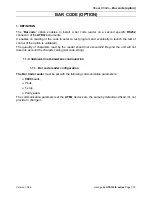
Appendix
EP-USB66
Page 19
Will the IDE ports on the EP-USB66 work with my hard drive and
CD-ROM?
If your devices are 40 pin they will most likely be detected. If your hard drive is listed
as IDE, EIDE, UltraDMA-33 or UltraDMA-66 it should function fine. A wide range of
devices such as CD-R, CD-RW, DVD, ATAPI CD-ROM, LS-120, Tape and ZIP
devices are also supported.
If using UltraDMA-66 drives you must use an 80-conductor / 40-pin ‘UltraDMA-66’
IDE cable (1 included) to attach the drive to the controller card. ‘UltraDMA-66’ IDE
cables are not required for UltraDMA-33 or older transfer modes but may still be used
with them. But this cable is required if newer UltraDMA-66 and older drives on to be
placed on the same controller port.
What is FAT32 and how do I use it?
Versions of Windows 95 older than OSR2, as well as any DOS version, operate on a
file system called FAT16. The existence of large hard drives has led to large partition
sizes, which mean large cluster sizes and wasted space. Under FAT16, a smaller cluster
size is better, because a small file takes up a whole cluster if there is even one byte in
it; the leftover space is called "slack." FAT16 does not support partitions larger than
2GB.
FAT32 is an improvement, as it supports drives up to 2 Terabytes in size, and cluster
sizes are 4K for partitions smaller than 8GB. Note that the minimum size of a FAT32
partition created with FDISK is 512MB. You cannot make FDISK/FORMAT format a
drive with the FAT32 file system if it is smaller than 512MB. You must use Windows
95 OSR2.0 or higher for FAT32.
To use FAT32 you must use the FDISK utility in Windows 95 OSR2.x (a.k.a.
Windows 95 B) or Windows 98. FDISK will only allow you to put FAT32 on drives
larger than 512MB. Once inside FDISK, you must enable "large disk support," to
choose FAT32. Proceed to partition the drive as usual, selecting drive/partition sizes,
etc. After exiting FDISK and rebooting, FORMAT (use the OSR2.x or 98 version
only) the drive. NOTE that you must manually reboot after exiting the OSR2.x (or
98) version of FDISK, this is not automatic as in previous versions of FDISK. If you
do not reboot between FDISK-ing and FORMAT-ing, you will get strange-looking
error messages.


































